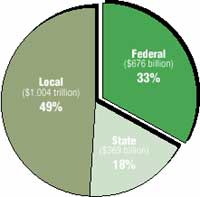State Surpasses $1 Billion in e-Procurement Transactions, and more
State Surpasses $1 Billion in e-Procurement Transactions
Virginia Governor Mark R. Warner officially made the purchase that put the state’s electronic commerce initiative, eVA, over the $1 billion mark in sales. The milestone represents nearly 155,000 orders since eVA was launched two years ago, and solidifies eVA’s reputation as the premier public-sector Internet purchasing system in the nation.
More than four million products are already posted on eVA by more than 13,000 private vendors, and available to more than 400 government agencies and institutions. Products range from fuel, vehicles, and maintenance services to office supplies. This year, construction and additional services like telecommunications will be added.
“eVA has enabled the Commonwealth to leverage its buying power across state and local government, increasing efficiencies and reducing costs,” says Governor Warner. “This milestone of $1 billion means we have changed our buying culture and shown Virginia to be a model for the nation in public-sector e-commerce.”
The system stimulates competition by enabling purchasing agents to easily shop online catalogs to compare prices and offers while reducing the administrative costs associated with doing business. It also levels the playing field for smaller vendors. Some 6,400 of eVA’s registered vendors are small, woman-owned, and minorityowned businesses. More than $190 million has been spent through eVA with small business transactions.
Electronic procurement reduces paperwork and unnecessary steps—saving both time and money. Private businesses spend about one percent of their procurement budget on processing; government spends 5.5 percent. Fully implemented, eVA is expected to reduce costs to the Commonwealth to about two percent—saving millions of dollars a year in processing costs.
“As an enterprise-wide, Web-based system, eVA allows every agency and institution in the Commonwealth to easily utilize technology for better performance and results,” said Secretary of Administration Sandra D. Bowen. “In surpassing the $1 billion mark, eVA continues to have the largest volume of any system of its kind. We expect the network to continue a rapid expansion as new entities embrace it to foster more effective negotiations with a broader spectrum of vendors.”
Governor Warner made the $1 billion mark purchase at the Virginia Department of Health (VDH), an agency that has been an early and avid supporter of electronic purchasing. VDH processed a more than $2.2 million purchase through eVA in the month of August. The purchase included lab supplies from Fisher Scientific International, Inc., a New Hampshire company.
Fisher Scientific has been engaged in what is now called electronic commerce for 36 years, and last year, e-commerce represented 22 percent of its total sales.
To build eVA, Virginia partnered with AMS, a global business and IT consulting firm headquartered in Fairfax, VA. The implementation was the fastest rollout of a statewide procurement system in the nation.
Additionally, the project did not require any up-front appropriations from the Commonwealth. AMS and Virginia used a unique funding model called reverse funding whereby AMS assumed the initial risk to build eVA and only received payment through funds generated by transaction fees once the system was operational.
The system has been awarded numerous accolades since its inception.
Most recently, the project was recognized as the 2003 State Government Innovator by the Massachusetts Institute of Technology (MIT) School of Architecture and Planning, along with Accenture. The system was also ranked first in the country by the Center for Digital Government’s 2002 Digital State Survey in the Electronic Commerce and Business Regulation Category. The Division of Purchasing and Supply in Virginia’s Department of General Services runs eVA.
The eVA electronic procurement system complements the efforts of a recent pilot project called Virginia Partners in Procurement. The effort negotiated new contracts in nine distinct categories of spending, and projected savings will reach between $28 and $34 million per year in these categories. Additionally, Governor Warner has authorized a new series of spending categories for the next phase of the “spend management” initiative.
Study Finds Bureaucratic Turnover Hurts Privatization of Service Efforts
A recent study finds that turnover among city administrators, and not mayors, makes efforts to privatize public services nearly impossible.
In the study of 237 U.S. cities with populations of 25,000 or more between 1988 and 1994, researchers examined the influence that mayoral and city administrator turnover and the racial makeup of the cities had on contractor choices for providing mental health programs and elderly services. Results indicated that private-sector organizations often resisted submitting bids in cities where city manager turnover was high, leading to what researchers call “privatization failure.”
“Private companies and nonprofits want long-term deals,” says University of Alabama at Birmingham (UAB) political scientist Christopher Stream, Ph.D, a co-author of the study. “If the city managers are rotating, it is seen by organizations as a sign of uncertainty and instability. But where city bureaucracies are more stable, the city is better able to be contracting with nonprofits.”
In contrast, mayoral turnover tended to have a positive impact on efforts to contract out services, researcher found, suggesting that electoral turnover does not cause the same problems in contract negotiations, enactments, and enforcement that are caused by administrative turnover.
The study suggests that term limits, which guarantee substantial turnover of elected officials, may in fact have no impact on the choice to privatize.
The researchers advise cities with high city manager turnover to recruit managers who are more likely to stay on the job. However, for cities with high administrative turnover, privatizing services or converting to a city-manager form of government should be avoided.
The study’s co-authors are James Clingermayer, Ph.D., of Western Kentucky University and Richard Feiock, Ph.d., of Florida State University.
Local Entities Save with Warehouse Club Pricing
Cities, counties, and school districts, and other local entities—there are 87,525 of them in the United States—have discovered the value and cost savings available at wholesale distributors.
The City of Avon, OH, buys from the Costco located within city limits. “For Avon, the ability to purchase necessary supplies and keep the money we are spending within the community is an important consideration,” Avon Mayor James A. Smith says. Mayor Smith lists these advantages for shopping at wholesale organizations: lower pricing; variety of merchandise; one-stop shopping; and the ability to buy in bulk.
For local governments, price is key, says Donna T. Beach, CPPO, CPPB, C.P.M., Director of Research and Technical Resources at the National Institute of Governmental Purchasing (NIGP).
| |
| |
 |
| |
“The main advantage is the huge purchasing volume that warehouse clubs deliver—so their prices are lower,” Beach notes. “Local government agencies are able to enjoy the lower prices through Costco and other warehouse clubs. Obviously, if you and I as consumers are going to buy a bulk amount, we go to Costco and similar operations, and the same discount translates for local governments.”
Shopping at warehouse clubs like Costco brings new convenience and time-savings to government, says Ruth Totton, senior buyer in the purchasing office of St. Lucie County (FL). “In the past I’ve faxed a purchase order to the club and they will have the merchandise all ready for me, and all we have to do is check the order.”
GSA Announces New RFP for Small Businesses
The U.S. General Services Administration’s (GSA) Heartland Region announced the release of the final solicitation for the 8(a) FAST2 Govern-mentwide Acquisition Contract (GWAC).
“The original FAST contract was a great success for both our 8(a) vendor partners and GSA, and we look forward to providing more opportunities for 8(a) businesses under FAST2,” says Donna Bennett, commissioner of GSA’s Federal Supply Service (FSS).
This second generation 8(a) GWAC is expected to build on the achievements of its predecessor, 8(a) FAST contracts for information technology, scheduled to expire in October 2004. As an offshoot of the former Federal Acquisition Services for Technology (FAST) program of GSA’s Federal Technology Service, the 8(a) FAST GWAC has shown tremendous success, with more than 11,500 orders, worth $1.6 billion in sales, from small, disadvantaged 8(a) firms, since the contracts were awarded in 1997.
“This solicitation is the first step and a great opportunity for small disadvantaged 8(a) firms to become a part of this unique contract vehicle designed to assist small businesses in competing in the federal marketplace,” says Stephen Triplett, assistant regional administrator for FSS in Kansas City.
GSA released a draft solicitation last summer to provide the business community an opportunity to review the proposed solicitation and to provide technical and business feedback to GSA on its content, format, clarity and any other relevant aspects.
“We’re proud of the relationship the Small Business Administration (SBA) has with GSA, and of our cooperation to further the success of small business,” said Fred Armendariz, SBA’s associate deputy administrator for Government Contracting/Business Development. “This new 8(a) contract vehicle is an example of a successful partnership between our agencies and with industry.”
One of the major changes from the first 8(a) GWAC is an expansion of functional areas, from one to eight based on the North American Industrial Classifications Standards, including Application Development, CAD/CAE/CAM Services, Network Design, Computer Operations/Sup-port, Data Processing/ Hosting, Imaging, Contingency Planning, Disaster Preparedness/Recovery, Information Assurance, Internet Publishing/Broadcasting, Call Centers, Distance Learning, and Point-to-Point Telecommunications.
The proposed contract term is a three-year base with option periods.
‘Mom-and-Pop’ Shops Grow
The number of businesses with no paid employees grew from more than 16.5 million in 2000 to almost 17 million in 2001, a rate of growth of 2.7 percent, according to the U.S. Census Bureau.
The rate of increase during the 1999 to 2000 period was 2.3 percent.
According to the report, Nonemployer Statistics: 2001, Georgia led the nation in the growth of small businesses with a 5.2 percent increase between 2000 and 2001. Comparisons of the top five states showed Nevada slipped from first place in 2000 to second place in 2001, with a 4.8 percent increase. New York, up 4.6 percent, ranked third in 2001. Florida, with a 4.2 percent increase, was in fourth place. Texas, with an increase of 3.8 percent, rounded out the top five states in nonemployer business growth.
Nationally, these small businesses make up more than 70 percent of all businesses. They may be run by one or more individuals, can range from home-based businesses to corner stores or construction contractors, and often are part-time ventures with owners operating more than one business at a time.
The report has data on 14.8 million individual proprietorships, and on more than 1 million corporations and l million partnerships.
Some of the detailed Internet tables show the number of establishments in nearly 300 industries and their receipts for the United States, states, counties, and metropolitan areas.
The report can be accessed at http://www.census.gov/prod/2003 pubs/ns-01.pdf.
Public Officials Take The Heat
Most public officials have to prove they’re tough under fire, but more than 30 mayors, city council members, and elected officials from California and across the United States and Canada got a chance to put those skills to the ultimate test at “Fire Ops 101.” The event was hosted by the International Association of Fire Fight-ers (IAFF) on Saturday, October 4.
Participants got a hands-on feel for the realities and risks of being a fire fighter and paramedic during a day-long interactive training session at the San Francisco Fire Department Training Center in San Francisco.
“The mission of our Fire Ops workshop is to educate our elected leaders about the real challenges of being a fire fighter and a paramedic by showing them first-hand what these brave men and women face every day,” says Harold Schaitberger, General President of the IAFF.
“After you get a feel about the dangers and stress of the job, it gives new meaning to esoteric words like response times and safe firefighter staffing,” Schaitberger adds.
Remote Areas Go Wireless for High-Speed Internet
Faced with the challenge of providing high-speed Internet access to their communities, some municipalities have chosen to develop their own network to meet the growing demand. One such location that has felt the effects of the digital divide is Allegany County in Maryland, which is situated in the Appalachian Mountains roughly 150 miles outside of Washington, DC, and Baltimore, MD.
The running of cable and fiber is financially prohibitive in areas such as Allegany County because of the difficult terrain, so the installation of a Wireless Internet Service Provider (WISP) was the answer.
The County began experimenting with unlicensed microwave technology in 1995 to connect 4,000 workstations in 90 buildings throughout the county and the City of Cumberland via AllCoNet, the county’s Intranet. But the county wanted an even more robust network. It hoped to retain and attract businesses by working with Internet Service Providers (ISPs) to offer a carrier class broadband network—to be called AllCoNet 2—to both business and residential customers.
The county watched as others began using unlicensed microwave networks to work toward the same goal.
Allegany County has since been able to breach the digital divide by deploying a combination of licensed and unlicensed microwave technology. This wireless broadband technology has made it possible for the county to create a functional network with carrier-grade reliability.
The Wireless ISP will provide high-speed Internet access to approximately 85 percent of residents, 95 percent of businesses, and 100 percent of government offices and industrial parks in Allegany County. The county plans to partner with local ISPs in the area, who will in turn provide Internet access.
The digital divide will not vanish overnight, but with the help of WISPs and companies like Stratex Networks, provider of Ethernet solutions, it will slowly diminish.




















